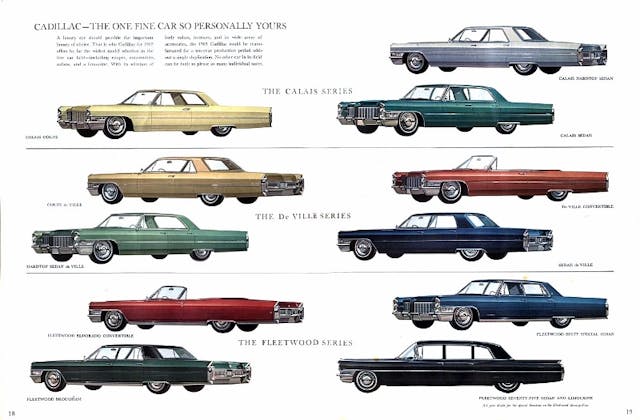Media | Articles
1965 Cadillac Fleetwood Seventy-Five: Yes, it really is a ’65

OK, let’s get one thing straight. This really is a 1965 Cadillac. This is, perhaps with the exception of the Pininfarina-built 1959–60 Cadillac Eldorado Brougham (frequently ID’d by Cadillac novices as a ’61 standard Cadillac), the most commonly misidentified Cadillac ever.

Go online. Post a picture and say, this is a 1965 Fleetwood Seventy-Five. Wait approximately one second. All manner of completely and totally sure “experts” will flock to your post. “That’s not a ’65! A 65 is completely different! That’s a ’64! I’d bet my bottom dollar on it!” Ah, but they’re wrong. Although you will have an almost impossible time convincing them of it.

You see, 99.9 percent of Cadillacs were totally redesigned in 1965, as were all full-size GM cars, from Chevrolet Biscayne to Pontiac Bonneville to Oldsmobile Eighty Eight. And every Cadillac from Series 62 to Coupe de Ville to Fleetwood Brougham. EXCEPT the Fleetwood limousines.
For some reason, known only to Cadillac Motor Division executives and GM product planners, the biggest, fanciest, and most expensive Cadillac of them all, the Seventy-Five Series, beloved by captains of industry and limo companies throughout the nation, retained the 1964 sheetmetal, dimensions, and trim.
No brand-new stacked quad headlamps. No ruler straight flanks with only a hint of fin in the totally redesigned quarter panels. Still with the 1959-style wraparound windshield and dogleg A-pillar.
Marketplace
Buy and sell classics with confidence
There were some differences. But not many. Basically two. First, they had the redesigned 1965 wheel covers, shared with all other Cadillacs that year. In addition, they had the brand-new triple-band whitewall design, but of course as years passed and those became unavailable, the wheel discs were about the only way to tell from the exterior.
There were some improvements under the hood though. The 429-cubic-inch V-8, first introduced in all Cadillacs in 1964, produced 340 horsepower and was backed by an improved Turbo Hydra-Matic automatic transmission.
This particular car was on display at the 2017 Des Moines Concours d’Elegance, held every year in the heart of downtown, by the Pappajohn Sculpture Park. My friend Dave Mitchell first told me about the event when he displayed his 1934 Cadillac V16 Town Car there.

I was extremely intrigued, and at his invitation I attended the 2016 event. It was grand. I took several hundred pictures and have since attended every year except for 2019, when the weather forecast called for thunderstorms, and in 2020—for obvious reasons.
This gorgeous creature was at the 2017 Concours d’Elegance, alongside an equally compelling 1959 Fleetwood Seventy-Five. I had never seen a ’65 Seventy-Five before, and this one was cooly elegant in dark gray metallic with dove gray interior. I began snapping away in earnest!
These were, as you’d expect, the most expensive Cadillacs. The limousine was THE most expensive. Sporting a power divider window between the rear compartment and the front seat, it retailed for $9960. A total of 795 were built. The Fleetwood Seventy-Five limousine tipped the scales at 5260 pounds. It was a lot of Cadillac, and the most expensive Cadillac of 1965.
The Seventy-Five sedan lacked the divider window, but was otherwise the same. It was only slightly less expensive, to the tune of $9746. Some 455 of these were made, and this car is one of them.
Finished in what appeared to be Ascot Gray, it had a regal presence at the show. I loved it. This one year anomaly amidst the rest of the 1965 Cadillacs would be corrected in 1966.

That year the Seventy-Fives were totally redesigned and finally shared their looks with the rest of their showroom mates. Fast forward 56 years and many folks will think these ’65s are ’64s. But now you know, as the late, great Paul Harvey frequently said, the rest of the story.



























I think the reasons there was a delay were: A. Low production numbers. At around 4,000 per year, there was not as much priority. B. Each were almost hand built so to retool the factory likely took a bit longer. They were produced at Plant 21 by Fisher Body until April Fool’s Day 1984. For the 1985 Fleetwood Seventy- Fives, Cadillac commissioned premier coach-builder Hess and Eisenhardt. Hess and Eisenhardt then used the front drive Coupe DeVille to create Fleetwood Seventy-Fives until their last production year, the 1987. The Fleetwood Seventy-Five’s demise was brought about by a steep decline in sales due to so much competition from other builders. Arguably the best was Moloney Coach-Builders. Also, quite frankly, Hess and Eisenhardt, usually known for building high quality vehicles, could have done a much much better job, even with the “Babyllac” front wheel drives. Robert Lane, Owner of a 1976 Fleetwood Seventy-Five Limousine.
What are the rectangular flat panels in the headliner with small dot pattern — AC vents? Does the whole panel move or is it decorative?